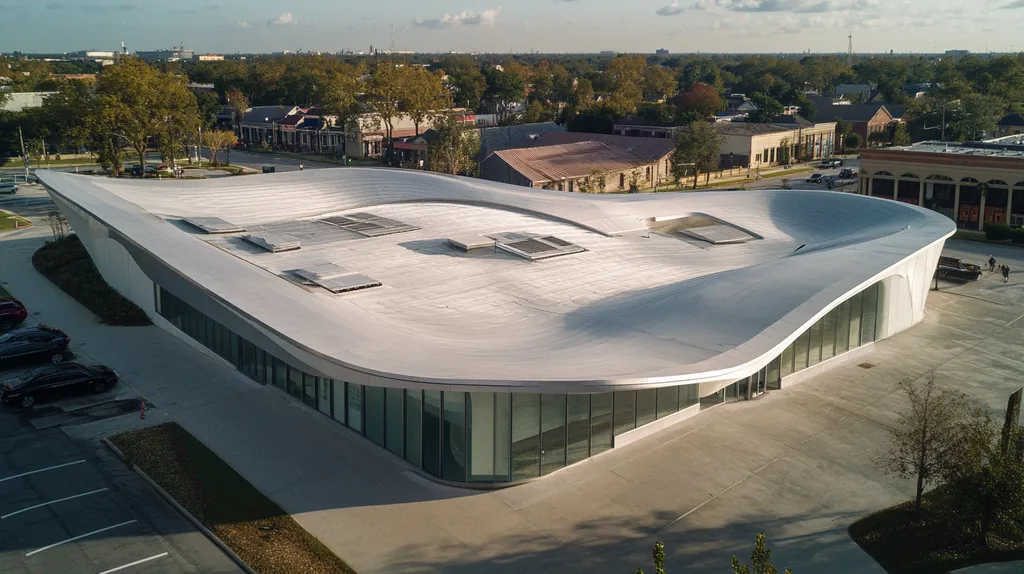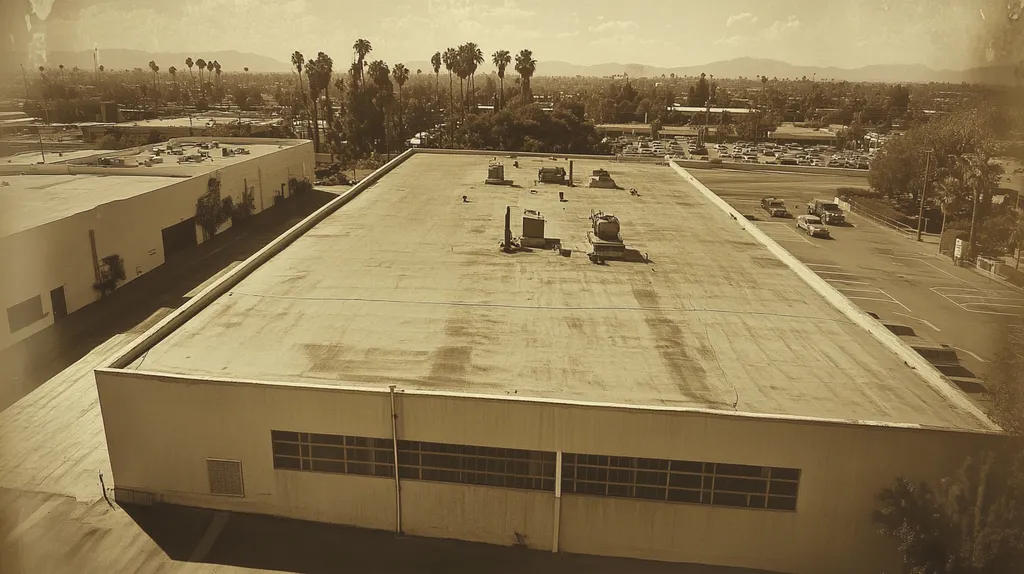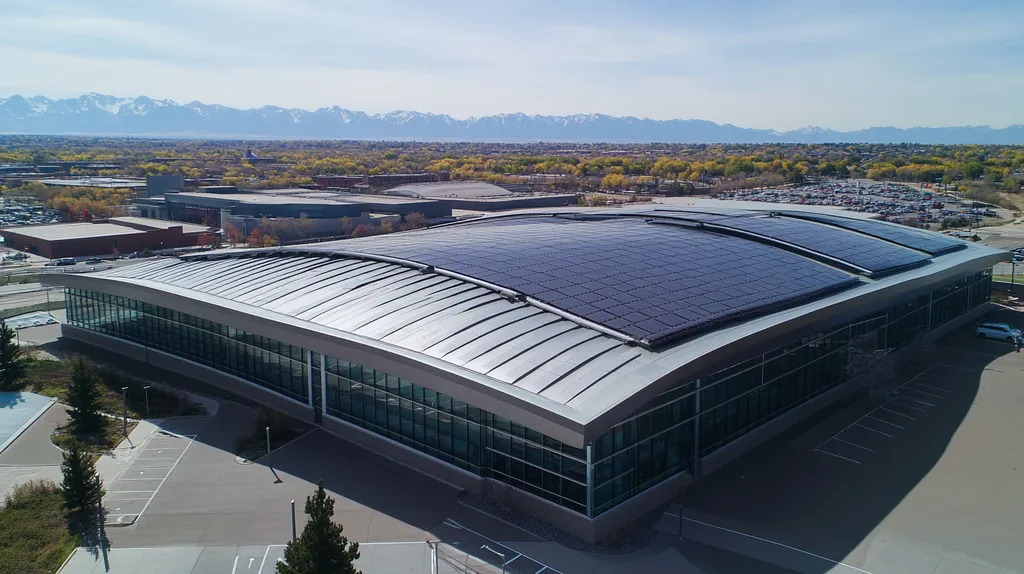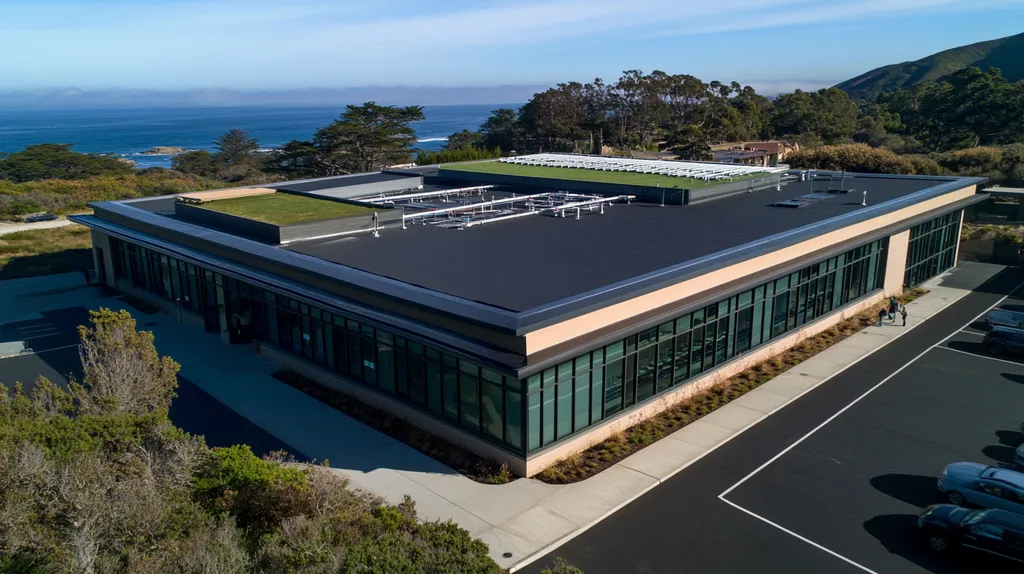In an era where commercial energy costs are skyrocketing, property owners can no longer afford to ignore the impact of roof coatings on building efficiency. Studies show that properly coated commercial roofs can reduce cooling costs by up to 30% while extending roof life by 15-20 years.
Yet widespread misconceptions about roof coatings continue to cost businesses millions in wasted energy and premature roof replacements. Understanding the science behind coating technology and its practical applications has become crucial for property owners seeking to optimize their building envelope performance.
This comprehensive analysis cuts through common myths to reveal how modern coating solutions are transforming commercial roofing efficiency through proven data and real-world examples.
SECTION 1: COMMON MISCONCEPTIONS
Recognizing the true value of roof coatings is essential for any property owner aiming to enhance energy efficiency and optimize building performance. Many mistakenly view roof coatings as just cosmetic upgrades, which can lead to overlooked opportunities for significant savings and improved efficiency. For instance, studies indicate that reflective coatings can cut energy consumption by as much as 25%. It’s crucial to address these myths to empower informed roofing choices.
Coatings Are Just for Aesthetic Purposes
A pervasive misconception is that roof coatings are solely for beautification. While a polished appearance is important, the true advantages of roof coatings reach far beyond aesthetics. They significantly enhance the durability of roofing systems and bolster a building’s resistance against harsh weather elements.
Take reflective coatings, for example—they can redirect solar heat, thereby lowering the temperature of the rooftop surface. This not only extends the lifespan of roofing materials but also lessens the reliance on cooling systems. Consequently, property owners need to understand that boosting efficiency and longevity are vital roles played by roof coatings.
Moreover, a thoughtfully selected coating can minimize maintenance costs, resulting in fewer repairs and longer intervals between replacements. Over time, this leads to significant savings. Thus, it becomes evident that coatings are much more than mere decorative options—they are smart investments that enhance performance.
For optimal results, property managers should weigh the functional benefits of coatings rather than fixating solely on their visual appeal. This strategic approach cultivates informed decision-making that can substantially improve financial outcomes.
All Roof Coatings Are Created Equal
Another misconception is the idea that all roof coatings provide identical benefits, which couldn’t be further from the truth. Each type of coating features its unique formulations and functionalities tailored to various roofing needs. Understanding these differences is essential for property owners to achieve the best potential outcomes.
For instance, silicone coatings excel in waterproofing capabilities while acrylic coatings are well-regarded for their UV resistance. These distinctions can influence a building’s energy efficiency and maintenance requirements dramatically.
Furthermore, it’s important to note that not all coatings adhere effectively to every roofing substrate. Mismatches can lead to premature failures, undermining any anticipated benefits. A careful selection process, possibly involving expert consultations, is crucial for finding the right fit.
Ultimately, a discerning approach is necessary when considering roof coatings. By grasping the unique properties of each type, property owners can maximize their efficiency and performance outcomes.
Coatings Do Not Impact Energy Efficiency
Many facility managers incorrectly assume that roof coatings don’t significantly affect energy efficiency. This perspective underestimates the substantial role modern coatings play in enhancing thermal performance. The proper coating has the potential to greatly reduce energy costs and elevate indoor comfort levels.
Reflective coatings are a prime example; they minimize heat absorption, resulting in lower cooling demands, especially during sweltering weather. By cooling the roofing system, these coatings lessen the burden on HVAC systems, leading to improved energy performance.
Data shows that when roof coatings are applied correctly, they can lead to air conditioning cost reductions of up to 20%. This represents significant savings for facility managers while also promoting a positive impact on the environment through decreased energy usage.
Property owners should challenge the notion that coatings have little to do with energy efficiency. Investing in high-quality roof coatings can offer remarkable financial and environmental benefits, making them a crucial asset in building management.
SECTION 2: PRACTICAL IMPLICATIONS
The efficiency of a building’s envelope is crucial, as it directly influences operational costs and environmental impact. For commercial properties, implementing roof coatings can lead to a substantial decrease in both cooling and heating demands. Research shows that reflective coatings can slash roof temperatures by up to 50°F, resulting in remarkable energy savings. These coatings not only enhance energy efficiency but also bolster the durability and performance of the roofing system. Understanding these practical implications empowers property owners to make decisions that are beneficial both financially and environmentally.
Impact on Cooling and Heating Demands
Temperature regulation within a commercial facility relies heavily on the efficiency of its roofing system. Reflective roof coatings play a key role in minimizing heat absorption, significantly lowering cooling costs during the summer months. Data reveals that buildings with reflective coatings can realize cooling savings of up to 30%.
In the colder months, some coatings can also help retain indoor heat, easing the burden on heating systems. By reducing temperature fluctuations, these coatings promote a stable indoor environment.
This stability not only enhances comfort for occupants but also reduces wear and tear on HVAC systems. As a result, property owners can expect lower maintenance costs over time, making roof coatings a prudent investment.
With energy costs continually on the rise, the financial advantage of reduced utility bills becomes even more compelling. Businesses investing in energy-efficient roofing solutions can achieve a competitive edge.
Effects on Roof Lifespan and Maintenance
Commercial roofs are subject to considerable challenges, including severe weather and UV radiation. Roof coatings act as a protective shield against these elements, which is essential for extending service life. Studies indicate that roofs with coatings can last an impressive 10 to 15 years longer than their uncoated counterparts.
By reflecting UV rays and repelling moisture, these coatings help to mitigate the risk of leaks and degradation. This translates into less frequent maintenance and lower costs associated with roof repairs.
Without coatings, regular maintenance can lead to expensive overhauls or premature replacements. Coated roofs streamline maintenance schedules and strengthen overall building integrity.
In the end, the lesser need for repairs results in lower total ownership costs. Property owners prioritizing roof coatings are not only prolonging roof lifespans, but they are also freeing up financial resources for other pressing building needs.
Influence on Urban Heat Island Effect
The urban heat island effect poses a growing challenge in cities, raising temperatures in densely populated areas. Roof coatings can be key in addressing this issue. Reflective coatings lower the temperatures of individual buildings while also cooling their surroundings.
Research indicates that cities adopting reflective roofing technologies can experience temperature reductions of between 2°F and 5°F. This contributes to better air quality and reduced energy consumption across urban environments.
Tackling the urban heat island effect represents a responsibility for property owners and facility managers alike. By adopting roofing solutions that address environmental issues, they can enhance community well-being while promoting a positive public image.
Thus, beyond financial savings, roof coatings also support sustainable development. Businesses committed to these technologies position themselves as frontrunners in the green building movement.
SECTION 3: COST OF MISINFORMATION
The cost of misinformation in roofing decisions can be staggering, with the potential for significant financial repercussions. According to studies by the U.S. Department of Energy, commercial roofs lacking proper coatings can see energy consumption costs soar by up to 30%. This mistake not only drains annual budgets but also leads to premature roof replacements and serious environmental issues. Grasping these costs is vital for property owners and facility managers aiming to make informed and impactful roofing decisions.
Increased Energy Consumption Costs
Inefficiencies in roofing choices can lead to substantial financial strain. Without reflective coatings, roofs absorb excessive heat, forcing air conditioning systems to work continuously. This excessive workload can drastically inflate energy consumption, resulting in higher utility bills.
For instance, a commercial building with a conventional roof might incur thousands of dollars more in operating costs annually compared to one that has been enhanced with an energy-efficient coating. Sustained high energy costs can severely impact profit margins, particularly for businesses heavily reliant on climate control.
Conversely, applying the right coating can yield long-term savings by reflecting sunlight and significantly reducing heat absorption. Studies indicate that buildings equipped with high-performing reflective coatings can achieve energy savings of up to 20% every year.
Ultimately, investing in effective roofing solutions not only addresses energy consumption but also directly reduces operational costs, positively influencing the bottom line.
Premature Roof Replacement Expenses
Neglecting effective roof coatings can lead to shortened lifespans, resulting in costly premature replacements. Unprotected roofs are more vulnerable to issues like leaks and cracks, which often necessitate expensive repairs or complete roof replacements.
The financial impact of replacing a roof can range from $5,000 to $50,000, depending on roof size and materials. Effective coatings play a crucial role in protecting and extending the life of a roof, delaying the need for costly replacements.
Moreover, the maintenance costs associated with uncoated roofs can escalate quickly. Regular repairs, inspections, and emergency fixes can burden budgets. High-quality coatings reduce these maintenance requirements, making roof management more efficient and cost-effective.
By making a wise investment in coatings today, property managers can save substantial sums in the future and increase financial security.
Environmental Impact of Inefficient Roofs
The environmental repercussions of poor roofing decisions are significant and far-reaching. Inefficient roofs contribute to the urban heat island effect, intensifying local temperatures and increasing energy consumption. This in turn raises greenhouse gas emissions due to heightened energy production demands.
Research shows that reflective roof coatings can decrease surface temperatures in urban areas by up to 30°F. Enhancing the reflectivity of commercial roofs can greatly reduce a building’s ecological footprint.
Furthermore, failing to utilize coatings often leads to premature roof replacement, adding more waste to landfills. By extending the lifespan of roofing materials through coatings, property owners can conserve resources and align with sustainable practices that are increasingly vital.
Tackling misinformation in roofing choices is crucial not just for financial stability but also for fostering environmental responsibility, creating a win-win scenario for property owners and the planet.
SECTION 4: REALITY CHECK
In an era of rising energy costs, the often-overlooked benefits of roofing coatings demand urgent attention. Reflective roof coatings can reduce energy costs by as much as 30%, according to the U.S. Department of Energy. Gaining a solid understanding of the scientific research, practical applications, and industry standards surrounding these coatings is essential for property owners aiming to optimize building performance and reduce expenses.
Scientific Studies on Reflective Coatings
Numerous scientific studies highlight the clear advantages of reflective coatings for commercial roofs. Research conducted by the Lawrence Berkeley National Laboratory shows that white or reflective coatings can significantly lower roof temperatures. This proactive temperature management leads to lower cooling demands, which in turn translates into impressive energy savings.
Moreover, a study published in the “Journal of Building Physics” demonstrates that roofs equipped with reflective coatings enhance thermal performance, effectively reducing the urban heat island effect. This reduction has far-reaching benefits for urban energy consumption and climate initiatives.
Despite compelling evidence from these reputable studies, many property owners choose to overlook the findings. Ignoring this valuable research can result in higher operating costs and reduced lifespan for roofing systems.
By understanding these significant results, property owners can make choices that align with best practices and sustainability goals, ensuring their investments yield substantial returns.
Real-World Case Studies and Data
Real-world applications of reflective coatings showcase their practical benefits in action. For example, a prominent retail chain expanded its energy-efficient initiatives by investing in reflective roof coatings for various locations. This strategic move resulted in average energy savings of 25% per location, substantially lowering their overall operational costs.
In another compelling instance, a large industrial facility applied reflective coating technology and reported a staggering 40% reduction in summer air conditioning use. This translated into significant annual savings, confirming the financial sense of choosing advanced coatings.
Additionally, industry data suggests that buildings sporting reflective roofing can enjoy an extended lifespan of up to 15 years compared to traditional roofing options. This increased longevity means fewer replacements, which not only saves money but also reduces environmental waste associated with discarded roofing materials.
These case studies provide powerful evidence supporting the adoption of coatings, highlighting measurable benefits that make a strong case for initial investments in energy efficiency.
Industry Standards and Certifications
The effectiveness and reliability of roofing coatings are further supported by established industry standards and certifications. The Cool Roof Rating Council (CRRC) provides benchmarks that help property owners identify top-performing products. Coatings that bear the CRRC label represent superior solar reflectivity and thermal performance.
Moreover, ENERGY STAR® certification reinforces the trustworthiness of these products. Roofs meeting these stringent requirements are proven to support energy savings, making them an appealing option for property owners looking to make eco-friendly choices.
Choosing products that comply with these recognized standards isn’t just about smart decision-making; it’s also a commitment to sustainability and efficiency. Property owners who prioritize certified coatings can unlock additional benefits, including rebates and incentives from energy providers and local governments.
Aligning roofing decisions with established industry standards not only ensures long-term savings but also enhances marketability in an increasingly environmentally-conscious landscape.
SECTION 5: EVIDENCE-BASED ALTERNATIVES
In a climate of escalating energy expenses and stringent environmental regulations, property owners must proactively seek sustainable roofing solutions. Innovative coatings, especially silicone and aluminum, have proven to be powerful tools for boosting the efficiency of building envelopes. These advanced materials not only significantly lower energy consumption but also extend the lifespan of roofing systems. This section explores the myriad advantages of these coatings, the significance of high solar reflectance options, and the growing availability of low volatile organic compound (VOC) water-based alternatives.
Benefits of Silicone and Aluminum Coatings
Silicone coatings are renowned for their exceptional waterproofing and UV resistance, making them perfect for flat and low-slope roofs. By reflecting sunlight, these coatings actively reduce roof temperatures and mitigate the urban heat island effect, benefiting both the environment and energy costs. On the other hand, aluminum coatings offer a highly reflective surface that minimizes heat absorption, resulting in notable energy efficiency enhancements.
Both types of coatings significantly increase the durability of roofing systems, often extending their lifespan by 10 to 20 years compared to untreated roofs. This longevity translates to substantial savings on replacements and repairs, while simultaneously boosting overall building performance.
Additionally, the reflective properties of silicone and aluminum coatings lead to decreased cooling costs, particularly in warmer climates. Property owners can expect noticeable reductions in energy bills, making these coatings a prudent financial decision. Importantly, both silicone and aluminum coatings can be applied directly over existing roofing surfaces, minimizing disruption to building operations.
Utilizing silicone or aluminum coatings is thus a smart, cost-effective strategy to enhance roof performance and achieve long-term financial savings.
Role of High Solar Reflectance Coatings
High solar reflectance coatings, commonly referred to as “cool roofing” solutions, are essential in maximizing energy efficiency. Designed to reflect more sunlight and absorb less heat, these coatings help keep buildings cooler during hot months, resulting in lowered air-conditioning costs and improved occupant comfort.
Research shows that high solar reflectance coatings can reduce roof surface temperatures by as much as 50°F under certain conditions. This reduction underscores their effectiveness in decreasing energy usage during peak demand periods. Many local and state governments incentivize the installation of cool roofs through rebates, making them a financially viable option.
Beyond just energy savings, these coatings support environmental sustainability by lessening energy consumption and consequently reducing greenhouse gas emissions linked to electricity generation. The increasing use of these coatings reflects a growing commitment to combating climate change and adopting sustainable building practices.
Ultimately, high solar reflectance coatings are key not only for enhancing commercial roof efficiency but also for aligning with broader environmental stewardship goals.
Water-Based and Low VOC Coating Options
The rising demand for eco-friendly solutions has spurred the development of water-based and low VOC coatings. These alternatives are crafted to minimize environmental impact while effectively protecting roofs. By utilizing water as a solvent, these coatings reduce harmful emissions, ensuring safer conditions for both applicators and building occupants.
Low VOC coatings significantly improve indoor air quality, an essential consideration for commercial buildings housing employees and vulnerable populations. By opting for these advanced solutions, facility managers uphold health standards while simultaneously enhancing energy efficiency through the reflective and protective qualities of the coatings.
Moreover, water-based coatings often feature quick drying times, allowing for more efficient installation with minimal operational downtime—an especially critical factor in commercial environments.
Embracing water-based and low VOC coatings represents a forward-thinking approach that advances sustainability in commercial roofing, ensuring compliance with evolving environmental regulations.
SECTION 6: TEST AND VERIFY
As commercial property owners grapple with rising energy costs and sustainability mandates, evaluating roofing system efficiency becomes paramount. Inadequate assessments can lead not only to heightened energy consumption but also to increased operating expenses. Validating the performance of roof coatings through rigorous testing and monitoring ensures buildings meet regulatory standards and remain environmentally responsible. This section delves into crucial practices for conducting energy audits, tracking performance over time, and ensuring compliance with energy efficiency regulations.
Conducting Energy Efficiency Audits
Energy audits stand as a cornerstone for assessing the effectiveness of roof coatings in commercial environments. These assessments analyze aspects like thermal performance and insulation integrity, uncovering areas ripe for enhancement. By employing thermal imaging and infrared scanning techniques, facility managers can actively detect heat loss and identify inefficiencies in their roofing systems.
Regular audits not only help establish benchmarks for energy performance but also drive informed decisions regarding roof upgrades. Additionally, thorough audits demonstrate a commitment to sustainable practices and align with energy efficiency standards, paving the way for greater energy savings once inefficiencies are rectified.
Outcomes from these periodic audits can facilitate improved budgeting for repairs. Early detection of leaks or energy losses helps mitigate long-term costs while prolonging the lifespan of roofing systems. Conducting energy audits empowers property owners to enhance their building’s overall efficiency.
Monitoring Roof Performance Over Time
For roof coatings to effectively yield energy savings, ongoing performance monitoring is essential. This practice entails routine inspections to spot signs of wear and tear that can hinder thermal efficiency. Implementing sensors and building management systems enables continuous feedback on temperature variations and energy usage.
Following established benchmarks from initial audits, facility managers can track performance over time. This data is crucial for spotting trends, such as rising energy consumption that may signal coating degradation. Quick action can then be initiated to address these concerns, safeguarding against costly repairs in the future.
Regular maintenance, guided by performance data, ensures that coatings function at peak efficiency. Properties prioritizing performance monitoring not only save on energy expenses but also maintain structural integrity. Enhancing the efficiency of the building envelope is a dual process: effective application followed by continuous verification.
Compliance with Energy Efficiency Regulations
Maintaining compliance with energy efficiency regulations is not merely a legal obligation; it’s a financial imperative. Numerous local and federal guidelines impose stricter energy consumption requirements for commercial properties. Non-compliance can result in severe fines and potential reputational damage.
Roof coatings frequently qualify for LEED credits and other energy efficiency recognitions. Understanding applicable standards enables property owners to leverage maximum energy performance benefits. By documenting compliance through audits and performance assessments, they can provide verifiable evidence to regulatory entities.
Moreover, being proactive about regulatory changes positions property owners favorably for future shifts in environmental policies. This proactive stance enhances reputation while increasing property value and tenant satisfaction. Routine monitoring for compliance ensures the investment pays off over time through lower utility bills and reduced operational risks.
The Bottom Line
With energy costs rising by 30% annually, commercial property owners can no longer afford to ignore the proven benefits of modern roof coatings.
Studies conclusively demonstrate that quality coatings reduce cooling costs by up to 30% while extending roof lifespans by 15-20 years, delivering an exceptional return on investment.
The evidence is clear: properly selected and applied roof coatings represent one of the most impactful ways to improve building envelope efficiency and reduce operational expenses.
As environmental regulations tighten and utility costs climb, facility managers who fail to leverage coating technologies risk falling behind more forward-thinking competitors.
The time for embracing these proven solutions is now – before rising energy costs and aging infrastructure create even greater financial burdens.
FREQUENTLY ASKED QUESTIONS
Q. Are coatings only for aesthetic purposes on commercial roofs?
A. Many believe coatings are simply cosmetic, but they offer real energy savings and durability. Reflective coatings, for example, cut energy consumption and prolong roof lifespan. Recognizing their functional benefits makes a significant difference for property owners.
Q. How do roof coatings impact energy efficiency for commercial roofs?
A. Roof coatings help regulate temperatures by reflecting solar heat, leading to lower cooling demands. This results in significant energy savings, particularly in hotter climates, helping facilities manage operational costs effectively.
Q. Do all roof coatings deliver the same benefits for industrial roofs?
A. Not all coatings are created equal. Different formulations excel in unique areas, such as waterproofing or UV resistance. Understanding these distinctions is vital for maximizing performance and efficiency when coating an industrial roof.
Q. What are the financial repercussions of misinformation about coatings?
A. Misinformation can lead to increased energy costs and premature roof replacements. Without proper coatings, energy consumption may rise significantly, impacting operational budgets negatively and resulting in unnecessary financial burdens.
Q. How can property owners ensure the performance of their roof coatings?
A. Regular energy audits and performance monitoring are essential. By assessing thermal performance over time and addressing any issues promptly, property owners can maximize the efficiency and longevity of their roof coatings.
Q. What are the benefits of advanced silicone and aluminum coatings for commercial roofs?
A. These coatings enhance waterproofing and UV resistance while significantly improving energy efficiency. They not only keep roofs cooler but also extend lifespans by reducing wear and tear, making them cost-effective options for commercial roofing solutions.
Q. Are there eco-friendly coating options for commercial roofs?
A. Yes, water-based and low VOC coatings minimize environmental impact while protecting roofs. These options improve indoor air quality and comply with sustainability standards, allowing property managers to maintain health-conscious environments without sacrificing energy efficiency.











